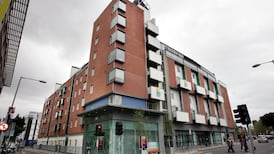Speed limits are set to be reduced across Dublin city for the first time in five years, including on main roads and arterial routes into the city centre.
Dublin City Council had been introducing 30km/h zones in residential areas on a phased basis over the last two decades.
In 2007 it lowered speed limits in the shopping and central business area of the city from 50km/h to 30km/h. From 2011 the zone was extended as far as Bolton Street on the north side to St Stephen’s Green on the south side, and from Church Street in the west to Gardiner Street and Dawson Street to the east. Parts of the Ballsbridge and Ringsend areas and Marino were also covered by the 30km/h restriction.
In 2018 it pushed the 30km/h limit out to 12 more southside suburbs and 19 on the northside.
READ MORE
In 2020, the last tranche of 30km/h zones was introduced, extending the speed limit to the residential areas of the remaining suburbs, excluding main roads and arterial routes, as far as the council’s boundary with the three other Dublin local authorities.
The council’s engineers proposed extending this limit to the remaining roads in the city, excluding a small number of routes, on the basis that “the vast majority of arterial roads in Dublin are in fact residential also”, Brendan O’Brien, the council’s head of traffic, said in 2021.
However, the council paused the process pending a review of national speed limit guidelines, with the expectation that a default speed limit in built-up and urban areas would be set at 30km/h. “All roads designed appropriately to accommodate higher speed limits would have their speed limits set through the introduction of special speed limit bylaws,” the council said.
The Road Traffic Act 2024 defined the default urban speed limit as 30km/h, but the council said “this particular section has not been enacted by the Minister [for Transport] and will not be for the foreseeable future. Therefore, the default speed limit in an urban area stays as 50km/h”.
Last month, the Department of Transport instructed the council to reduce speed limits through new bylaws governing individual roads, rather than applying a default limit of 30km/h.
“The hope was we would have had a 30km/h default,” Mr O’Brien told city councillors on Wednesday. “When you drop from 50km/h to 30km/h, you still get some people who drive at 50km/h, but the average speed comes down. So we still think there was a lot of value in it.”
It would also have removed the need for the “plethora” of 30km/h signage, he said.
The council engineers will now begin the process of assessing the remaining roads in the city, with current speed limits of 50km/h, 60km/h, and 80km/h for potential reductions.
Initially, it will “identify roads that are suitable for immediate transition to 20 and 30km/h speed limits”.
On other roads, engineering interventions will be required to slow traffic and prevent or deter motorists from breaking the 30km/h limit. New street layouts should be implemented, which support “the lower proposed speed limit and use engineering design measures to make the street ‘self-enforcing’,” the council said.
“Pedestrian priority roads” will be assessed for a proposed speed limit of 20km/h, the council said, “it should be noted that this speed limit will be the posted speed and will apply to service and delivery vehicles when on these roads, as well as cyclists and e-scooter users”.
New bylaws will be drafted and made available for public consultation before implementation.












